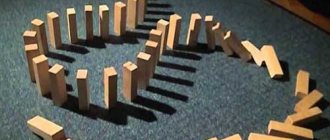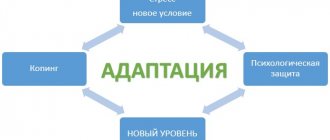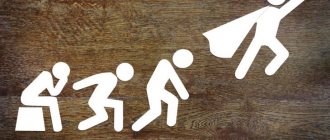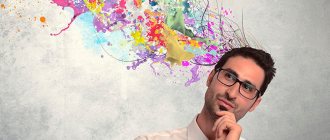To study well, work, and achieve success in life, it is important to use different types of thinking.
And we will talk about what types and forms of thinking exist in the article. And we will also answer the question: how to develop thinking in an adult?
Don't forget to subscribe to our Telegram channel - there is a lot of useful materials from the world of education. And keep an eye on promotions and discounts from the company to learn even more profitably.
Help is needed?
Entrust your work to a PhD candidate!
More details about the concepts
It is impossible to understand this issue in detail without finding out the definitions of all terms. Thinking is the process of processing information data and bringing it to a specific conclusion. This ability gave rise to the emergence of speech, which we use to communicate with each other. People come to reflection in order to resolve all troubles and problems, explore the world around them, find out relationships and patterns. By thinking, a person creates innovations, makes scientific discoveries and finds himself in art. Without a mental component, we would be similar to ordinary animals that act within the framework of their instincts.
Forms of thinking are the result of thought and mental processes that manifest themselves in a specific situation, which allows one to understand the essence of phenomena and objects, determine the relationships of objects and notice general signs. There are only three varieties, which I will discuss in detail below.
Judgment
Judgment as a form of thinking involves confirmation or denial of some fact, event, property, feature, connection. It manifests itself in phrases, but we must remember that not every phrase is a judgment. Thus, an interjection or a one-syllable sentence does not belong to this form of thinking (examples: “Oh!”, “How is that possible?”).
Sentences tend to be narrative in nature: “The Earth revolves around the Sun.”
A proposition can be true or false, which is determined by logic. The first involves the presence of one subject with characteristics or the comparison of two subjects.
When a simple judgment is separated, the words cease to carry a semantic load. Example: “A mouse is smaller than a cat.” If this sentence is divided into two, the meaning is lost.
Complex judgments are various combinations that consist of a complex and a simple, two complex or two simple judgments. Examples: “If it hails, the plants may be damaged.” Here, “plants may be harmed” appears as a simple proposition.
Judgment as a form of thinking of a complex nature is impossible without grammatical connectives (“but”, “or”, “and”, “if so, then...”, “when..., then...”, etc.).
It is necessary to distinguish between judgment and other logical forms of thinking: a concept is expressed in a word, and a conclusion is expressed in a conclusion.
This form of thinking can also be:
- affirmative (“Botany is the science of plants”, “The tiger is a predator”);
- negative (“This sentence is constructed incorrectly”, “In Russian cities there are no bears walking on the streets”).
There is another classification. A general judgment presupposes a statement (negation) that refers to phenomena, subjects, united by a common concept (“All healthy cats have four paws”). Particular implies a part of objects, subjects, phenomena that are united by a concept (“Some poets are graphomaniacs”). An individual property is expressed in a single judgment (“F.M. Dostoevsky is the author of “Crime and Punishment””).
In essence, a judgment reveals the content of a concept (or several) - therefore, in order to make a statement, it is necessary to know the content of all the concepts used.
Main forms
All of them are strongly interconnected and are an integral part of the implementation of the thought process, thanks to which we have the opportunity to carry out analysis, synthesis, and build a logical connection. This gradually leads to the development of intelligence. These varieties are studied in the sciences of psychology and logic.
Concept
It reflects general and abstract signs in the phenomena and objects that surround us. This reflection is varied. There is the following classification of features (similarities or differences) by volume:
- Are common. Inherent in each personality (creation of tools, mastery of articulate speech, thinking skills).
- Single. Belong to one person (physique, gait, gestures).
By content:
- Specific – a set of objects that can exist independently (“reform”, “unity”, “state”).
- Abstract – it is not the objective component that is meant, but its attribute (“responsiveness”, “injustice”). We do not perceive these terms as separate things, they only complement the statement, for example, “responsive people”, “unfair treatment”. The abstract type does not have a plural in Russian.
This form is also divided into the following types:
- immediate, reflections are built “here and now”;
- mediation, understanding is achieved through discussions and lengthy reasoning.
The concept reflects phenomena and their totality in an abstract form based on significant similarities or differences. It is associated with the main linguistic unit - the word. It is fixed in phrases, without which the formation of the conceptual process will not occur. Having formed a concept, scientific disciplines reflect the phenomena or objects being studied in them. For example, the science of “Economic theory” formed the terms: “capital”, “demand”, “supply”, “cost”, “products”.
Functions:
- Cognitive – formed as a result of identifying common subject features. During conceptual formation, unified properties are comprehended that help to understand the essence of an object.
- Communicative – proves that the concept is a component of communication. Having recorded our thoughts and knowledge, we exchange them when communicating with each other, and also, based on experience, pass them on to a new generation. This is how the social inheritance of knowledge occurs.
The most important indicator of assimilation of information is its awareness. For example, you may use a term without knowing exactly what it means, but if you fully understand its meaning, you will not appear incompetent. Therefore, awareness is considered an important link in connecting concept and understanding.
Judgment
This is a designation of the connection between the parameters, relationships and qualities of objects in the reality around us. The essence is the denial or justification of relationships. When forming an opinion, a person uses already conscious information and thereby affects both mental activity and the senses and memory.
Psychologist Daria Milai
Make an appointment
There are two types:
- Formal. Characterizes the fact of the relationship of objects without indicating the truth of the statement or falsity (“cloudy weather”).
- Empirical. Describes phenomena as a result of observation, and allows you to check for authenticity (“look how cloudy the weather is”).
Judgment reflects both falsehood and truth. According to the nature of the expression, there are two varieties:
- True - all conclusions are confirmed by reality.
- False – all assumptions are unproven and do not correspond to reality.
Components of opinion formation:
- The subject is a statement that must either be confirmed or rejected.
- A predicate is an affirmation or negation of the characteristics of objects.
An example would be: “The person has articulate speech.” Now let's try to distinguish the first term from the other. The subject in this case is “Man”, and the predicate is “has articulate speech”.
This form of thinking also varies in degree of complexity. There are two groups:
- Simple (“Russian and mathematics are the main school disciplines”).
- Difficult (“If you attend all lectures, you will pass all exams perfectly”).
Inference
This is the highest level of thinking, which leads to new knowledge using existing knowledge. Inference processes are carried out only using logic. Main components:
- premises – initial judgments from which a new one follows;
- conclusions – fresh information obtained in a logical way;
- conclusions - the transition from premises to final information based on logic.
I will give the basic classification of species. Depending on the severity of the rules, there are:
- Demonstrative. The main conclusion is formed from the premises.
- Non-demonstrative. The conclusion does not depend on the initial judgments.
Based on the availability of knowledge and connections between them, they are divided into:
- Induction is the transition of personality from the particular to the general. Specific assumptions are followed by uniform conclusions.
- Deduction - here, on the contrary, a person goes from the general to the specific.
- Analogy - when identifying important features of objects, a conclusion arises.
- Assumption is a type that does not involve evidence. He only puts forward theories that can be criticized and refuted.
Modern types of thinking: general characteristics of thinking and methods of development
However, these are not all the types of thinking that modern psychologists and cognitive specialists identify. In our life we cannot do without the ability to think strategically, critically and imaginatively. But these are also types of thinking. They are the ones who help a person to be successful, set ambitious goals and achieve them.
So, let's look at what popular types of thinking exist, what they are, and what methods and exercises can be used to develop them.
Necessary types of thinking for a modern person:
- Critical thinking.
- Strategic thinking.
- Logical thinking.
- Analytical thinking.
- Thinking outside the box.
- Creative or creative thinking.
- Systems thinking.
- Creative thinking.
- Spatial thinking.
- Abstract thinking.
- Algorithmic thinking.
- Deductive thinking.
- Associative thinking.
- Mathematical thinking.
By the way! Our readers now have a 10% discount on any type of work.
Critical thinking
What is critical thinking and how to develop it? The ability to think critically means the ability to doubt, ask questions, analyze, form judgments based on received arguments and defend one’s point of view.
Critical thinking is an essential skill for a student. It is he who helps to choose the right literature and competently work with sources during the preparation of coursework, dissertations and other works.
How to develop critical thinking in an adult? There are several proven methods:
- constantly improve knowledge, learn new things and expand your horizons;
- communicate with smart people;
- learn to ask questions and look for answers;
- read a lot and analyze what you read;
- explore different points of view;
- come up with different options for how situations might develop;
- analyze mistakes and failures, draw conclusions;
- play chess, board games;
- solve puzzles and rebuses.
Solving puzzles helps develop thinking
Strategic Thinking
Strategic thinking is the ability to assess the risks of your actions and anticipate the consequences. Any thinking person must develop the art of seeing and creating strategies to achieve success in different areas of life.
What examples of strategic thinking can you give? The most relevant is the attitude towards learning. If a student makes a study and preparation plan at the beginning of the school year, this strategy will allow him to prepare for tests and exams with ease and confidence. But the “at random” attitude is more likely to lead to a retake.
How to develop strategic thinking? Focus on the following skills:
- observe events and look for general trends;
- ask difficult questions and try to find answers to them;
- always evaluate actions in terms of possible consequences;
- learn to think logically and clearly;
- make decisions and take responsibility;
- take time to take stock and evaluate the situation;
- constantly learn something new to expand your knowledge;
- learn to be open-minded;
- put yourself in another person's place.
Logical thinking
Logical thinking is the ability to think logically, reasoning consistently and consistently.
How to develop logical thinking as an adult? This is a very important question. After all, logic helps not only in study and work. She is an excellent travel companion in any life situation. So take note of the following exercises and ways to develop logical thinking:
- solve logical problems;
- read and analyze the texts you read;
- solve scanwords, crosswords and puzzles;
- look for logical patterns;
- study foreign languages;
- learn to write with your left hand if you are right-handed, and vice versa.
Writing with your left hand if you're right-handed is a great way to practice thinking.
Analytical thinking
Analytical thinking is the ability to work with large data of information, dividing them into logical parts and examining each according to a certain scheme.
It is impossible to think analytically without well-developed logic. Therefore, in searching for an answer to the question: how to develop analytical thinking, do not forget about the advice from the previous paragraph and supplement them with the following:
- solve math problems;
- analyze situations and information;
- look for alternative solutions;
- participate in discussions;
- learn to create smart and clear notes;
- simulate different situations.
Thinking outside the box
Non-standard, or lateral thinking is the ability to think outside the box in ordinary situations and look for unexpected solutions.
British psychologist Edward de Bono studied issues of lateral and creative thinking, and shared his findings in books. For example, in his work “Six Thinking Hats” you can find simple and effective exercises that help develop non-standard thought processes.
British psychologist Edward de Bono
How to develop unconventional thinking? Use proven exercises:
- go beyond: always look for additional solutions and properties, not limited to standard conditions;
- look for ways to use it: take any item and come up with at least 100 options for how it can be used;
- connect random words: find relationships between different objects and phenomena.
Creative or creative thinking
Creative or creative thinking is very similar to lateral thinking. It also characterizes a person’s ability to create something new and non-standard, bypassing the usual rules and patterns. The ability to think creatively helps you come up with ideas and change this world for the better.
Creativity is the most important soft skill of our time. HR managers of large companies want to see this skill not only in specialists in creative professions, but also in managers and technical workers.
How to develop creative or creative thinking? Use the following proven techniques:
- change the situation, go beyond;
- switch between tasks rather than sit on one thing;
- come up with ideas on your own and discuss them in a general brainstorming session;
- listen to happy music - studies say it improves creative thinking;
- develop a sense of humor and a positive attitude towards life;
- reproduce other people's ideas and create your own based on them.
Systems thinking
The ability to think systematically is an important skill for managers. But it will also be useful in any professional field. After all, systems thinking is a holistic perception of phenomena and objects, the ability to find and create a system by working with information, people and companies.
Systematic thinking is important not only for professional development. This ability helps to organize life, set goals and see ways to achieve them.
How to develop systems thinking? Perform simple steps every day:
- look for a system in all situations and processes;
- find the main elements that make up the system;
- develop the ability to analyze and synthesize;
- approach every situation critically;
- try to predict the development of the system;
- develop the ability to reflect, that is, conduct introspection and evaluate oneself from the outside;
- Read books to develop systems thinking, such as Ian McDermott and Jane O'Connor's The Art of Systems Thinking.
Seeing a system in everything is an invaluable skill that will definitely come in handy in life.
Creative thinking
Imaginative thinking is the ability to “draw” mental images of phenomena and objects that are not in the immediate environment.
Figurative thinking, as a rule, relies on a person’s visual memory. But this does not mean that we cannot imagine abstract phenomena or animals that we have never seen. In this case, everyone will have their own images.
How to develop imaginative thinking? For this, psychologists recommend different exercises. For example:
- study objects, people, natural phenomena, and then describe them with your eyes closed;
- choose abstract phenomena and try to mentally draw their images;
- develop photographic memory;
- observe clouds or other abstract phenomena and find images.
Spatial thinking
Spatial thinking is a type of figurative thinking, which is characterized by the ability to navigate well in space, as well as mentally create three-dimensional images and forms.
How to develop spatial thinking? Even if you skipped geometry classes as a child at school and always suffered from topographic cretinism, there are methods that will help improve this ability:
- solve geometry problems;
- try to draw mental maps of the area;
- start designing airplanes, castles, etc.;
- collect puzzles;
- draw mirror reflections of paintings;
- play board games.
Abstract thinking
Abstract thinking is one of the types of thinking that allows you to create abstract concepts and operate with them.
It is the ability to think abstractly that helps a person communicate, learn different languages, count and read, and write.
How to develop abstract thinking? To do this, you can use the following methods:
- imagine different emotions;
- read the book in reverse order;
- come up with contradictory phrases;
- make up abbreviations;
- choose an item and write down all its functions and properties;
- write down all the words starting with a certain letter within a limited time;
- give names to life events.
Brainstorm with friends to develop your thinking
Algorithmic thinking
The algorithmic type of thinking includes the ability to direct the thought process to solve certain problems, see other people’s algorithms and create your own.
Algorithmization of processes is their description with mathematical symbols, in which it is necessary to reflect the basic acts of the processes, their sequence and interconnection.
If you want to go into IT, you just need to know how to develop algorithmic thinking. Here are some ways:
- study computer science;
- play strategy games;
- get involved in programming;
- break down different processes into steps.
Deductive Reasoning
Deductive thinking is the ability to draw specific conclusions from general phenomena. That is, it is a skill that allows you to notice small details and come to accurate conclusions.
Deduction is also an important research method that students use in the practical part of coursework and dissertations. So a well-developed skill will help you not only guess moves in the Sherlock series, but also be a great student.
How to develop deductive thinking? There are several important and useful ways:
- pay attention to little things;
- develop memory;
- learn to formulate thoughts clearly and logically;
- deeply study the chosen field of knowledge;
- train concentration;
- study other people's body language;
- keep a diary and record all the events of the day;
- develop intuition;
- solve puzzles and logic problems;
- learn to listen and hear others;
- read a lot.
Becoming a real Sherlock is a very real task
Associative thinking
Associative thinking is a person’s ability to see and create relationships between different images.
The ability to associatively helps a person better remember information, imagine different ideas, create stories and find relationships between phenomena. How to develop associative thinking in adulthood? There are several ways:
- build associative chains between different words;
- remember a number of words through associations;
- look for associative definitions for different phenomena;
- come up with unusual associations for familiar objects.
What are the forms of thinking based on logic: examples
Following the logical structure of mental activity, the following processes are put forward:
- comparison;
- analysis;
- abstraction;
- synthesis;
- generalization.
The comparative operation is based on determining the similarities and differences between phenomena. The result is a classification, which serves as the primary stage of theoretical understanding.
Face-to-face consultation
What are the features and advantages of face-to-face consultation?
Find out more
Skype consultation
What are the features and benefits of Skype consultations?
Find out more
Analysis is the procedure of dividing one significant object into various parts or characteristics, followed by comparison.
Synthesis - with its help you can mentally create a complex object from analytical components.
Abstraction – highlights significant properties and connections of phenomena and abstracts from insignificant ones. This is a process of detailed study, as a result of the research, concepts are formed.
Generalization is the ordering of objects according to common and essential characteristics.
Mental operations occur on the basis of logical ones, but this does not always work as a mechanism in which only reason and logic function. Very often emotions interfere with this process and completely change it. Since the emotional component has the ability to change and stimulate mental activity. Feelings tend to impart tension, goal-seeking, and ambition. Without emotions, productivity is reduced to zero, just as without logic, knowledge and skills.
Introductory section. Logic as a science
Logic has a long and rich history, inextricably linked with the history of the development of society as a whole.
The emergence of logic as a theory was preceded by the practice of thinking going back thousands of years. With the development of labor, material and production activities of people, there was a gradual improvement and development of their thinking abilities, especially the ability to abstraction and inference. And this, sooner or later, but inevitably should have led to the fact that the object of research became thinking itself with its forms and laws.
History shows that individual logical problems appeared before the human mind over 2.5 thousand years ago - first in Ancient India and Ancient China. They then receive more complete development in Ancient Greece and Rome. Only gradually does a more or less coherent system of logical knowledge take shape and an independent science take shape.
What are the reasons for the emergence of logic? There are two main ones. One of them is the origin and initial development of sciences
, especially astronomy and mathematics. This process dates back to the 6th century. BC e. and receives its most complete development in Ancient Greece. Born in the struggle against mythology and religion, science was based on theoretical thinking, involving inferences and evidence. Hence the need to study the nature of thinking itself as a means of cognition.
Logic arose primarily as an attempt to identify and justify those requirements that scientific thinking must satisfy in order for its results to correspond to reality.
Another, perhaps even more important reason, which is especially useful for lawyers to know, is the development of oratory
, including the judiciary, which flourished under the conditions of ancient Greek democracy. The greatest Roman orator and scientist M. Cicero, speaking about the power of the orator, the owner of the “divine gift” of eloquence, emphasized: “He can safely remain even among armed enemies, protected not so much by his staff as by his title of orator; he can, with his word, arouse the indignation of his fellow citizens and bring down punishment on the guilty of crime and deception, and save the innocent from trial and punishment by the power of his talent; he is able to motivate timid and indecisive people to heroism, is able to lead them out of error, is able to inflame them against scoundrels and calm the grumbling against worthy men; he knows how, finally, with one word he can both excite and calm any human passions when the circumstances of the case require it.”4
In addition to political and solemn speeches, the development of eloquence was especially promoted by the multitude, variety and significance of judicial cases. Well-prepared judicial speeches revealed an enormous power of persuasion that shook the minds of the listeners and, at the same time, great coercive power. She literally forced them to lean towards one opinion or another, to draw one conclusion or another.
Logic also arose as an attempt to reveal the “secret” of this coercive power of speeches. It was necessary to identify and understand what exactly its source is, what it is based on, and, finally, to show what properties speech should have in order to convince listeners, and at the same time force them to agree or disagree with something, to recognize to recognize something as true or not to recognize it.
According to Cicero, Greece “truly burned with a passion for eloquence and was famous for it for a long time...”5. It is no coincidence that it was Ancient Greece that became the birthplace of logic as a science. It is also natural that the term “logic” itself is of ancient Greek origin.
The founder of logic - or, as they sometimes say, the “father of logic” - is considered to be the greatest ancient Greek philosopher and encyclopedist Aristotle (384–322 BC). It should, however, be taken into account that the first fairly detailed and systematic presentation of logical problems was actually given by the earlier ancient Greek philosopher and naturalist Democritus (460 - approximately 370 BC). Among his numerous works was an extensive treatise in three books, “On Logical, or On the Canons” (from the Greek kanon - prescription, rule). Here, not only were the essence of knowledge, its basic forms and criteria of truth revealed, but also the huge role of logical reasoning in knowledge was shown, a classification of judgments was given, some types of inferential knowledge were strongly criticized, and an attempt was made to develop inductive logic - the logic of experimental knowledge.
Unfortunately, this treatise of Democritus, like all the others, has not reached us. However, it was widely used by Aristotle in his development of a grand system of logic. And modern logic directly stems from it.
Aristotle owns a number of treatises on logic, later united under the name “Organon” (from the Greek organon - tool, instrument).
The focus of all his logical reflections is the theory of inferential knowledge
–
deductive reasoning and evidence
. It was developed with such depth and care that it has passed through centuries and has largely retained its meaning to this day. Aristotle also gave a classification of categories - the most general concepts and a classification of judgments close to Democritus; he formulated three fundamental laws of thinking - the law of identity, the law of contradiction and the law of the excluded middle. Aristotle's logical teaching is remarkable in that in embryo it contains, in essence, all the later sections, directions and types of logic - inductive, symbolic, dialectical. True, Aristotle himself called the science he created not “logic,” but primarily “analytics,” although he used the term “logical.” The term “logic” itself entered scientific circulation somewhat later, in the 3rd century. BC e. Moreover, in accordance with the dual meaning of the ancient Greek word “logos” (both “word” and “thought”), he combined both the art of thinking - dialectics, and the art of reasoning - rhetoric. Only with the progress of scientific knowledge did this term begin to designate logical problems proper, and dialectics and rhetoric emerged as other independent branches of knowledge.
Being a gigantic generalization of the previous practice of thinking, Aristotle's logic had a powerful influence on its subsequent development, and above all on scientific knowledge. Thus, under the strong impression of this science, the famous “Elements” of Euclid (about 323–283 BC) were written. They summed up the majestic result of the development of Greek mathematics over the previous three centuries and for the first time the deductive method of constructing a scientific theory was manifested in practice with such force. Assessing the historical significance of Euclid's work as a practical application of logic, A. Einstein emphasized that this amazing work gave the human mind the self-confidence that was so necessary for its subsequent activities.
Aristotle's logic also significantly influenced the development of oratory, especially judicial speeches. Thus, one of the theorists of rhetoric, Hermagorus, around the middle of the 2nd century. BC e. developed the famous “system of finding,” which was the highest achievement of the rhetorical theory of the Hellenistic era. All the variety of judicial “incidents” (cases) is reduced in it to a single scheme of types and varieties (“statutes”), which was used by speakers in speeches.
In turn, logic itself received further development both in Greece and in other countries, both in the West and in the East. This development was caused, on the one hand, by the continuous improvement and enrichment of the practice of thinking (in which scientific knowledge occupied an increasingly greater share), and on the other, by an ever deeper penetration into the essence of thought processes. And it manifested itself not only in an increasingly complete and accurate interpretation of the existing range of problems, but also in the consistent expansion of the subject of logic by putting forward and analyzing more and more new problems. Initially this was expressed, for example, in the detailing and generalization of Aristotle's theory of deduction. Along with the intensified development of the theory of inferences from simple judgments, new forms of deductive inference from complex judgments were also studied. This is, for example, the logic of the Stoics (Zeno, Chrysippus - 3rd century BC). By the way, it is they who have the honor of introducing the term “logic” into scientific circulation.
In the Middle Ages, the problem of general concepts - “universals” - received great public attention. The dispute about them lasted for centuries and had a significant influence on the subsequent development of logic. However, in general, Aristotelian logic acquired a scholastic character, divorced from life and science; the pace of its development has slowed down significantly.
During the Renaissance, logic was experiencing a real crisis. It was regarded as the logic of “artificial thinking” based on faith, which was opposed to natural thinking based on intuition and imagination.
A new, higher stage in the development of logic begins in the 17th century. This stage is organically connected with the creation within its framework, along with deductive logic, of inductive logic.
. It reflects the diverse processes of obtaining general knowledge based on increasingly accumulated empirical material. The need for obtaining such knowledge was most fully realized and expressed in his works by the outstanding English philosopher and natural scientist F. Bacon (1561–1626). He became the founder of inductive logic. “... The logic that we now have is useless for the discovery of knowledge,”6 he pronounced his harsh verdict. Therefore, as if in contrast to Aristotle’s old “Organon,” Bacon wrote “The New Organon...”, where he outlined inductive logic, which he regarded as the “art of discovery.” He paid his main attention to the development of inductive methods for determining the causal dependence of phenomena. This is Bacon's great merit. However, the doctrine of induction he created, ironically, turned out to be not a denial of previous logic, but its further enrichment and development. It contributed to the creation of a generalized theory of inference. And this is natural, because, as will be shown below, induction and deduction do not exclude, but presuppose each other and are in organic unity. Bacon’s dreams of creating a logic of “scientific discovery” also turned out to be unrealistic.
Inductive logic was later systematized and developed by the English philosopher and scientist J. St. Mill (1806–1873) in his two-volume work “A System of Syllogistic and Inductive Logic.” It significantly influenced the further development of scientific knowledge and contributed to its achievement of new heights.
The needs of scientific knowledge not only in the inductive, but also in the deductive method in the 17th century. most fully embodied by the French philosopher and scientist R. Descartes (1596–1650). In his main work, “Discourse on the Method...”, based primarily on data from mathematics, he emphasized the importance of rational deduction as the main method of scientific knowledge.
Followers of Descartes from the monastery in Port-Royal, A. Arno and P. Nicole, created the work “Logic, or the Art of Thinking.” It became known as the Port-Royal Logic and was used for a long time as a textbook on this science. In it, the authors went far beyond the boundaries of traditional logic and paid main attention to the methodology of scientific knowledge and the logic of discovery. Logic was considered by them as a cognitive tool of all sciences. The creation of such “extended logics” became typical in the 19th–20th centuries.
Russian scientists made a well-known contribution to the development of traditional formal logic. Thus, already in the first treatises on logic, starting around the 10th century. attempts were made to independently comment on the works of Aristotle and other scientists. Original logical concepts in Russia were developed in the 18th century. and were associated primarily with the names of M. Lomonosov (1711–1765) and A. Radishchev (1749–1802). The heyday of logical research in our country dates back to the end of the 19th century. Thus, M. Karinsky (1840–1917) created an original general theory of inferences - both deductive and inductive. The works of his student L. Rutkovsky (1859–1920) were devoted primarily to the main types of inferences, their further development, and represented, in fact, a special case of a more general theory of logical relations. S. Povarnin (1870–1952) sought to develop a general theory of relations in logic. Traditional logic received further development during the years of Soviet power. It is being successfully developed to this day.
Main types
They are divided by functions and capabilities. The classification includes three successive stages of thinking development. They are created on the basis of genetic principle
Visually effective type
Characterized by observation of real objects and their relationships in reality. Such cognitive action is a fundamental element of any mental processes. This type of mental activity is actively used by children under 3 years of age. Gradually developing, they:
- compare things with each other, placing one on top of another;
- conduct experiments by breaking their favorite toy in half;
- synthesize by building various elements from Lego;
- make a classification by sorting the cubes by color.
The baby does not plan anything or set a goal; he thinks during the action, since it precedes his thoughts. But in adults, this type also occurs when rearranging furniture or using equipment that has never been used. In these cases, everything cannot be foreseen and controlled; something can definitely get out of control.
Visual-figurative type
Relies on representation and images. It promotes analysis, comparison and generalization. This type is closely associated with imagination. It manifests itself in children aged 4 to 7 years, they are able to learn things without using practical experience, they do not need to identify an object by touch, they perceive and remember it visually. For example, clarity is manifested in the fact that when asked: “Why is the car moving?” - the child may answer: “Because it is green.”
This type also manifests itself in adult life when planning repairs. A person imagines the interior design in advance, how he would like to arrange the furniture, what color wallpaper to choose or paint the walls. Visual-figurative thinking makes it possible to think through all things to the smallest detail, but they are invisible.
Verbal-logical type
This is a later type of development of mental activity. It is characterized by the use of various terms and the compilation of logical structures. Thanks to this, a person is able to establish common connections and predict the development of processes in nature or society. This type proceeds according to a specific sequence: first a judgment is involved, then another is added to it, and when they are combined, a conclusion arises.
Thinking: what is it?
Before talking about the types of thinking and their characteristics, let's figure out what is called thinking:
Thinking is a mental process during which cognition and reflection of objective reality occurs through ideas, judgments and concepts. This is the highest form of human creative activity.
Thinking has several important characteristics:
- it helps a person to understand the world indirectly, through mediated experience;
- always relies on information received through the senses;
- operates through generalization, which allows us to highlight the essential qualities of objects and phenomena.
“I think, therefore I exist,” Rene Descartes, a 17th-century mathematician and philosopher, considered thinking to be the most important human ability.
Time has passed, but this idea has not lost its relevance. After all, a lot depends on thinking, or rather on the quality of thought processes: the ability to solve life problems, see cause-and-effect relationships, set and achieve goals, and achieve success.
Briefly about the development of forms of thinking: psychology of thought
While still studying at school, a person already masters mental activity and begins to operate with concepts. There are several steps to forming a conceptual process:
- familiarity with certain things and phenomena;
- identification of characteristics of objects;
- selection of the most essential properties;
- designating them with a specific word.
For example, children at 2-3 years old point with a finger at some thing (a toy car), then when they grow up and turn 4-5 years old, they begin to highlight a common feature that is of greatest importance (a toy is designed to play her). At 5-6 years old, children describe things, listing their properties without any sequence (a car has wheels, a steering wheel, a trunk, headlights). Having become one more year older, the child begins to select the most basic characteristics (a toy car is a child’s toy, a dog is an animal, a plate is dishes).
Ask a question
Sometimes understanding is not acquired at all, then illogicality (fantasticity) occurs - this is an unusual and original reasoning that does not lend itself to the laws of logic. The reasons for this are:
- Lack of knowledge and lack of experience.
- Replacing unfamiliar task conditions with familiar ones.
- Inconsistent expression of thoughts.
Ways to correctly draw conclusions:
- search for expediency in reality;
- determining the purpose and essence of surrounding things;
- finding connections between external characteristics and functions of objects.
Properties of the thought process
- Direction is the main feature of thoughts. This indicates that every statement and reflection has its own completeness and purpose.
- Direction both to the future and to the past - a person can think about what happened to him yesterday, or, conversely, analyze what to do in a given situation.
- Concept formation using mental activity. She tries to characterize, organize, determine the similarities and differences of things.
- Logic is an essential element of reasoning.
How to develop children's thinking: methods
There are several basic techniques for expanding a child’s horizons:
- Talk to him more, explain even the most basic things. Use in your speech many unfamiliar words, epithets, and phraseological units. Pause, change the pace and length of your sentences.
- Make a sharp transition from one topic to another, or describe in great detail every little detail (description of a song, poetry or weather) in all colors.
- Walk through places unfamiliar to him, pay attention to everything (tree, bush, flowers, landmark, animals, birds).
- Listen together to music of a wide variety of styles from classical to rock.
- View images in books or family photos.











